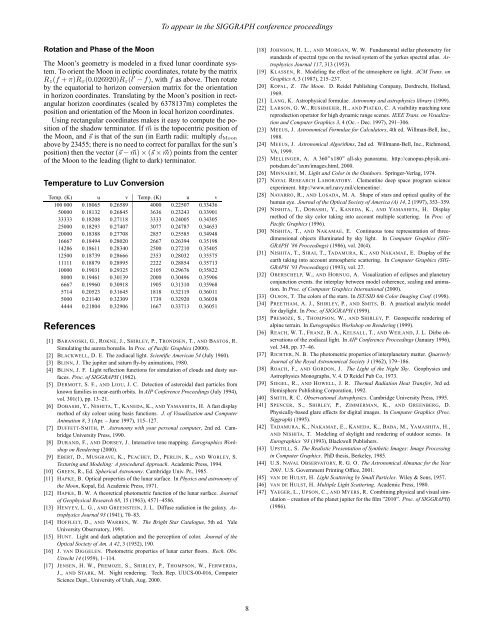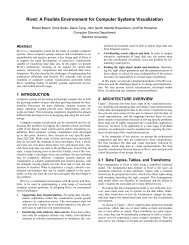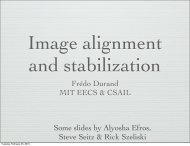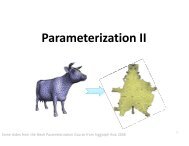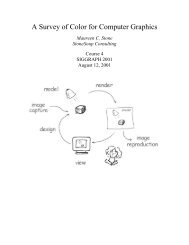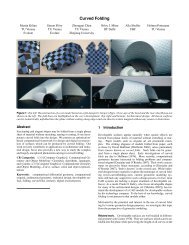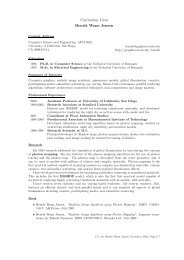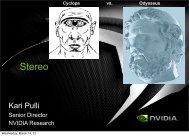A Physically-Based Night Sky Model - Computer Graphics Laboratory
A Physically-Based Night Sky Model - Computer Graphics Laboratory
A Physically-Based Night Sky Model - Computer Graphics Laboratory
Create successful ePaper yourself
Turn your PDF publications into a flip-book with our unique Google optimized e-Paper software.
Rotation and Phase of the Moon<br />
The Moon’s geometry is modeled in a fixed lunar coordinate system.<br />
To orient the Moon in ecliptic coordinates, rotate by the matrix<br />
Rz(f + π)Rx(0.026920)Rz(l ′ − f), with f as above. Then rotate<br />
by the equatorial to horizon conversion matrix for the orientation<br />
in horizon coordinates. Translating by the Moon’s position in rectangular<br />
horizon coordinates (scaled by 6378137m) completes the<br />
position and orientation of the Moon in local horizon coordinates.<br />
Using rectangular coordinates makes it easy to compute the position<br />
of the shadow terminator. If �m is the topocentric position of<br />
the Moon, and �s is that of the sun (in Earth radii: multiply dMoon<br />
above by 23455; there is no need to correct for parallax for the sun’s<br />
position) then the vector (�s − �m) × (�s × �m) points from the center<br />
of the Moon to the leading (light to dark) terminator.<br />
Temperature to Luv Conversion<br />
Temp. (K) u v Temp. (K) u v<br />
100 000 0.18065 0.26589 4000 0.22507 0.33436<br />
50000 0.18132 0.26845 3636 0.23243 0.33901<br />
33333 0.18208 0.27118 3333 0.24005 0.34305<br />
25000 0.18293 0.27407 3077 0.24787 0.34653<br />
20000 0.18388 0.27708 2857 0.25585 0.34948<br />
16667 0.18494 0.28020 2667 0.26394 0.35198<br />
14286 0.18611 0.28340 2500 0.27210 0.35405<br />
12500 0.18739 0.28666 2353 0.28032 0.35575<br />
11111 0.18879 0.28995 2222 0.28854 0.35713<br />
10000 0.19031 0.29325 2105 0.29676 0;35822<br />
8000 0.19461 0.30139 2000 0.30496 0.35906<br />
6667 0.19960 0.30918 1905 0.31310 0.35968<br />
5714 0.20523 0.31645 1818 0.32119 0.36011<br />
5000 0.21140 0.32309 1739 0.32920 0.36038<br />
4444 0.21804 0.32906 1667 0.33713 0.36051<br />
References<br />
[1] BARANOSKI, G., ROKNE, J., SHIRLEY, P., TRONDSEN, T., AND BASTOS, R.<br />
Simulating the aurora borealis. In Proc. of Pacific <strong>Graphics</strong> (2000).<br />
[2] BLACKWELL, D. E. The zodiacal light. Scientific American 54 (July 1960).<br />
[3] BLINN, J. The jupiter and saturn fly-by animations, 1980.<br />
[4] BLINN, J. F. Light reflection functions for simulation of clouds and dusty surfaces.<br />
Proc. of SIGGRAPH (1982).<br />
[5] DERMOTT, S. F., AND LIOU, J. C. Detection of asteroidal dust particles from<br />
known families in near-earth orbits. In AIP Conference Proceedings (July 1994),<br />
vol. 301(1), pp. 13–21.<br />
[6] DOBASHI, Y., NISHITA, T., KANEDA, K., AND YAMASHITA, H. A fast display<br />
method of sky colour using basis functions. J. of Visualization and <strong>Computer</strong><br />
Animation 8, 3 (Apr. – June 1997), 115–127.<br />
[7] DUFFETT-SMITH, P. Astronomy with your personal computer, 2nd ed. Cambridge<br />
University Press, 1990.<br />
[8] DURAND, F., AND DORSEY, J. Interactive tone mapping. Eurographics Workshop<br />
on Rendering (2000).<br />
[9] EBERT, D., MUSGRAVE, K., PEACHEY, D., PERLIN, K., AND WORLEY, S.<br />
Texturing and <strong>Model</strong>ing: A procedural Approach. Academic Press, 1994.<br />
[10] GREEN, R., Ed. Spherical Astronomy. Cambridge Univ. Pr., 1985.<br />
[11] HAPKE, B. Optical properties of the lunar surface. In Physics and astronomy of<br />
the Moon, Kopal, Ed. Academic Press, 1971.<br />
[12] HAPKE, B. W. A theoretical photometric function of the lunar surface. Journal<br />
of Geophysical Research 68, 15 (1963), 4571–4586.<br />
[13] HENYEY, L. G., AND GREENSTEIN, J. L. Diffuse radiation in the galaxy. Astrophysics<br />
Journal 93 (1941), 70–83.<br />
[14] HOFFLEIT, D., AND WARREN, W. The Bright Star Catalogue, 5th ed. Yale<br />
University Observatory, 1991.<br />
[15] HUNT. Light and dark adaptation and the perception of color. Journal of the<br />
Optical Society of Am. A 42, 3 (1952), 190.<br />
[16] J. VAN DIGGELEN. Photometric properties of lunar carter floors. Rech. Obs.<br />
Utrecht 14 (1959), 1–114.<br />
[17] JENSEN, H. W., PREMOZE, S., SHIRLEY, P., THOMPSON, W., FERWERDA,<br />
J., AND STARK, M. <strong>Night</strong> rendering. Tech. Rep. UUCS-00-016, <strong>Computer</strong><br />
Science Dept., University of Utah, Aug. 2000.<br />
To appear in the SIGGRAPH conference proceedings<br />
8<br />
[18] JOHNSON, H. L., AND MORGAN, W. W. Fundamental stellar photometry for<br />
standards of spectral type on the revised system of the yerkes spectral atlas. Astrophysics<br />
Journal 117, 313 (1953).<br />
[19] KLASSEN, R. <strong>Model</strong>ing the effect of the atmosphere on light. ACM Trans. on<br />
<strong>Graphics</strong> 6, 3 (1987), 215–237.<br />
[20] KOPAL, Z. The Moon. D. Reidel Publishing Company, Dordrecht, Holland,<br />
1969.<br />
[21] LANG, K. Astrophysical formulae. Astronomy and astrophysics library (1999).<br />
[22] LARSON, G. W., RUSHMEIER, H., AND PIATKO, C. A visibility matching tone<br />
reproduction operator for high dynamic range scenes. IEEE Trans. on Visualization<br />
and <strong>Computer</strong> <strong>Graphics</strong> 3, 4 (Oc. - Dec. 1997), 291–306.<br />
[23] MEEUS, J. Astronomical Formulae for Calculators, 4th ed. Willman-Bell, Inc.,<br />
1988.<br />
[24] MEEUS, J. Astronomical Algorithms, 2nd ed. Willmann-Bell, Inc., Richmond,<br />
VA, 1999.<br />
[25] MELLINGER, A. A 360 ◦ x180 ◦ all-sky panorama. http://canopus.physik.unipotsdam.de/˜axm/images.html,<br />
2000.<br />
[26] MINNAERT, M. Light and Color in the Outdoors. Springer-Verlag, 1974.<br />
[27] NAVAL RESEARCH LABORATORY. Clementine deep space program science<br />
experiment. http://www.nrl.navy.mil/clementine/.<br />
[28] NAVARRO, R., AND LOSADA, M. A. Shape of stars and optical quality of the<br />
human eye. Journal of the Optical Society of America (A) 14, 2 (1997), 353–359.<br />
[29] NISHITA, T., DOBASHI, Y., KANEDA, K., AND YAMASHITA, H. Display<br />
method of the sky color taking into account multiple scattering. In Proc. of<br />
Pacific <strong>Graphics</strong> (1996).<br />
[30] NISHITA, T., AND NAKAMAE, E. Continuous tone representation of threedimensional<br />
objects illuminated by sky light. In <strong>Computer</strong> <strong>Graphics</strong> (SIG-<br />
GRAPH ’86 Proceedings) (1986), vol. 20(4).<br />
[31] NISHITA, T., SIRAI, T., TADAMURA, K., AND NAKAMAE, E. Display of the<br />
earth taking into account atmospheric scattering. In <strong>Computer</strong> <strong>Graphics</strong> (SIG-<br />
GRAPH ’93 Proceedings) (1993), vol. 27.<br />
[32] OBERSCHELP, W., AND HORNUG, A. Visualization of eclipses and planetary<br />
conjunction events. the interplay between model coherence, scaling and animation.<br />
In Proc. of <strong>Computer</strong> <strong>Graphics</strong> International (2000).<br />
[33] OLSON, T. The colors of the stars. In IST/SID 6th Color Imaging Conf. (1998).<br />
[34] PREETHAM, A. J., SHIRLEY, P., AND SMITS, B. A practical analytic model<br />
for daylight. In Proc. of SIGGRAPH (1999).<br />
[35] PREMOZE, S., THOMPSON, W., AND SHIRLEY, P. Geospecific rendering of<br />
alpine terrain. In Eurographics Workshop on Rendering (1999).<br />
[36] REACH, W. T., FRANZ, B. A., KELSALL, T., AND WEILAND, J. L. Dirbe observations<br />
of the zodiacal light. In AIP Conference Proceedings (January 1996),<br />
vol. 348, pp. 37–46.<br />
[37] RICHTER, N. B. The photometric properties of interplanetary matter. Quarterly<br />
Journal of the Royal Astronomical Society 3 (1962), 179–186.<br />
[38] ROACH, F., AND GORDON, J. The Light of the <strong>Night</strong> <strong>Sky</strong>. Geophysics and<br />
Astrophysics Monographs, V. 4. D Reidel Pub Co, 1973.<br />
[39] SIEGEL, R., AND HOWELL, J. R. Thermal Radiation Heat Transfer, 3rd ed.<br />
Hemisphere Publishing Corporation, 1992.<br />
[40] SMITH, R. C. Observational Astrophysics. Cambridge University Press, 1995.<br />
[41] SPENCER, S., SHIRLEY, P., ZIMMERMAN, K., AND GREENBERG, D.<br />
<strong>Physically</strong>-based glare effects for digital images. In <strong>Computer</strong> <strong>Graphics</strong> (Proc.<br />
Siggraph) (1995).<br />
[42] TADAMURA, K., NAKAMAE, E., KANEDA, K., BABA, M., YAMASHITA, H.,<br />
AND NISHITA, T. <strong>Model</strong>ing of skylight and rendering of outdoor scenes. In<br />
Eurographics ’93 (1993), Blackwell Publishers.<br />
[43] UPSTILL, S. The Realistic Presentation of Synthetic Images: Image Processing<br />
in <strong>Computer</strong> <strong>Graphics</strong>. PhD thesis, Berkeley, 1985.<br />
[44] U.S. NAVAL OBSERVATORY, R. G. O. The Astronomical Almanac for the Year<br />
2001. U.S. Government Printing Office, 2001.<br />
[45] VAN DE HULST, H. Light Scattering by Small Particles. Wiley & Sons, 1957.<br />
[46] VAN DE HULST, H. Multiple Light Scattering. Academic Press, 1980.<br />
[47] YAEGER, L., UPSON, C., AND MYERS, R. Combining physical and visual simulation<br />
– creation of the planet jupiter for the film ”2010”. Proc. of SIGGRAPH)<br />
(1986).


